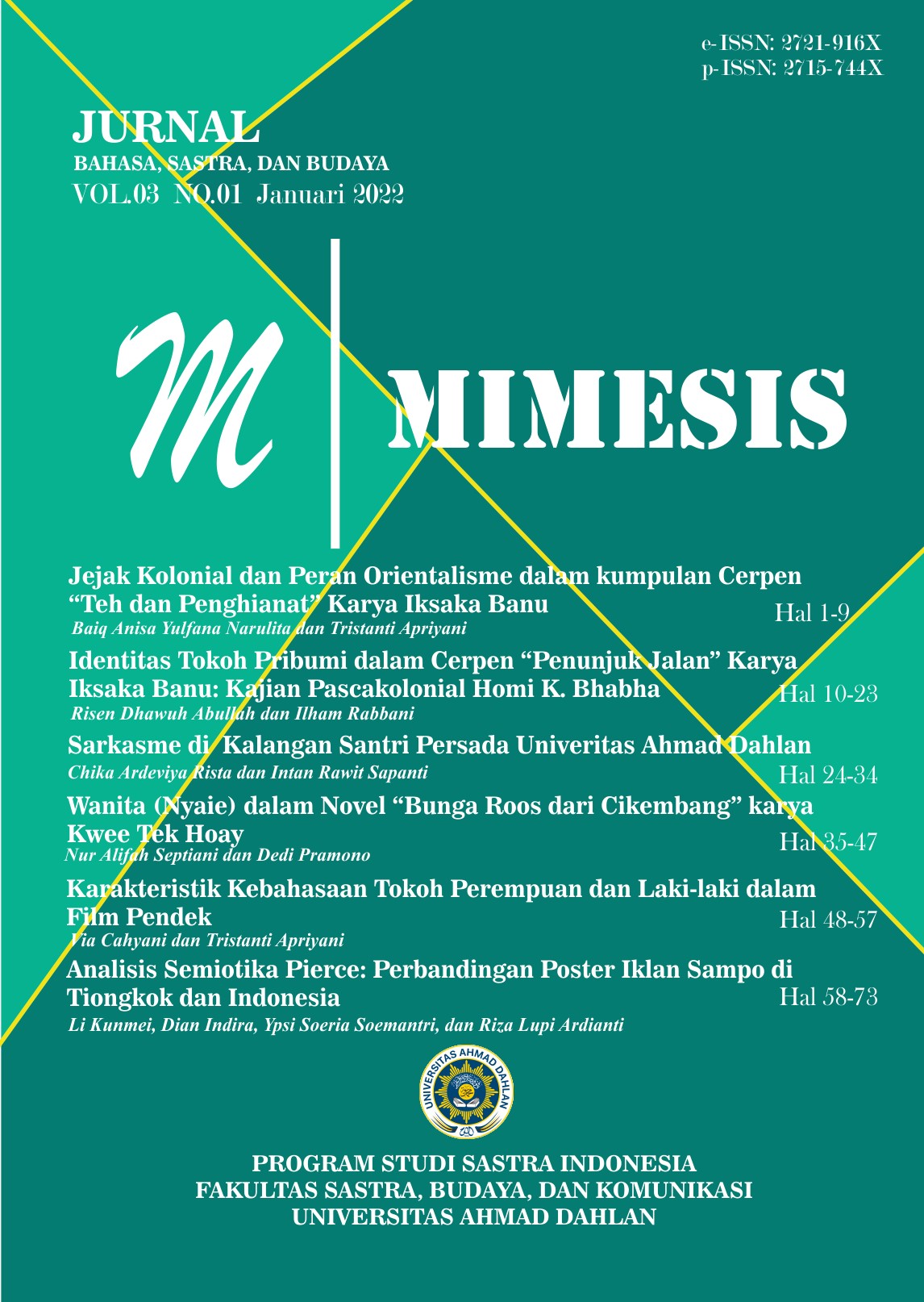KARAKTERISTIK KEBAHASAAN TOKOH PEREMPUAN DAN LAKI-LAKI DALAM FILM PENDEK
DOI:
https://doi.org/10.12928/mms.v3i1.5558Keywords:
Language, Gender, Short filmAbstract
Research is motivated by the differences in the language used by men and women. Environmental factors and society assume that women are gentle creatures, causing women to be careful about the choice of words in speech. Characteristics of women's language coined by Lakoff (1975) became a reference in this study. The problem discussed in this research is how the characteristics of women's language in the short film Reunian and the characteristics of men's language in the short film Dodit Not Penculik. This study aims to describe the linguistic characteristics of women and men in the two short films. The method used in this paper is descriptive qualitative, and quantitative with the subject of the short film Reunian and the short film Dodit Not The Kidnapper. The data acquisition in this study used the method of observing the free-engagement technique and the note-taking technique. Then the analysis in this study is that women tend to be unsure of their speech because women are very concerned about social norms and protect their self-esteem by using more polite speech.
References
Apriyani, T. (2020). Pembelajaran sastra populer berbasis wattpad sebagai upaya peningkatan kemampuan literasi baca tulis. Suar Betang, 15(1), 107–116. https://doi.org/10.26499/surbet.v15i1.152
Brown, P., & Levinson, S. C. (1987). Politeness: some universals in language usage (studies in interactional sociolinguistics 4). In Cambridge University Press. https://doi.org/10.2307/3587263
Creswell, J. W. (2014). Research design: pendekatan kualitatif, kuantitatif, dan mixed. Pustaka Pelajar.
Febriani, I. (2021). Representasi Bahasa Perempuan dalam Novel Suluk Mu’tazilah karya Hasnan Singodimayan. Jurnal Metabasa, 3(1), 10–17.
Fitriyani, I., Wilian, S., & Yusra, K. (2019). Ekspresi Bahasa Indonesia Tulis berdasarkan Gender pada Media Facebook. LINGUA: Journal of Language, Literature and Teaching, 16(1), 137–156. https://doi.org/10.30957/lingua.v16i1.581
Hanna, H. E. F. (2012). Hedges movie dialogues in english: theoretical and practical aspects. The journal for Languages and Literature of the Faculty of Philosophy Univerzitet u ovom Sadu. The Journal for Languages and Literature of the Faculty of Philosophy Univerzitet u Ovom Sadu, 11, 177–192.
Harimansyah, G. (2011). “Diksi laki-laki dan Perempuan“ dalam puisi-mutakhir indonesia (kajian sosiolinguistik-genderistik). Widyariset, 14(1), 143–152.
Hasanah, H., & Wicaksono, N. H. (2021). Bahasa dan Gender: Karakteristik Kebahasaan Perempuan Jawa dalam Film “Tilik.” Jurnal Budaya FIB UB, 2(1), 7–16. https://jurnalbudaya.ub.ac.id7
Hidayati, N. N. (2016). Bahasa dan Gender: Kajian Karakteristik Kebahasaanlaki-Laki dan Perempuan dalam Film Anak. AL HIKMAH Jurnal Studi Keislaman, 6(1), 9–32.
Holmes, J. (2013). An introduction to sociolinguistics. In The Modern Language Journal. Routledge. https://doi.org/10.2307/329116
Lakoff, R. T. (1975). Language and woman’s place. Harper & Row Publisher.
Rasyid, H., Mansyur, & Suratno. (2009). Asesemen perkembangan anak usia dini. Multi Pressindo.
Sugiyono. (2014). Metode penelitian kuantitatif, kualitatif dan R&G. Alfabeta.
Sumarsono. (2014). Sosiolinguistik. Pustaka Pelajar.
Umar, N. (2010). Argumen Kesetaraan Gender. Pustaka pelajar.
Wardhaugh, R., & Fuller, J. M. (2015). An introduction to sosiolinguistics. Blackwell.
Wijana, I. D. P., & Rohmadi, M. (2011). Sosiolinguistik: kajian teori dan analisis. Pustaka Pelajar.
Downloads
Published
Issue
Section
License
Copyright (c) 2022 Via Cahyani, Tristani Apriyani

This work is licensed under a Creative Commons Attribution-ShareAlike 4.0 International License.
License and Copyright Agreement
In submitting the manuscript to the journal, the authors certify that:
- They are authorized by their co-authors to enter into these arrangements.
- The work described has not been formally published before, except in the form of an abstract or as part of a published lecture, review, thesis, or overlay journal.
- That it is not under consideration for publication elsewhere,
- That its publication has been approved by all the author(s) and by the responsible authorities tacitly or explicitly of the institutes where the work has been carried out.
- They secure the right to reproduce any material that has already been published or copyrighted elsewhere.
- They agree to the following license and copyright agreement.
Copyright
Authors who publish with Mimesis agree to the following terms:
- Authors retain copyright and grant the journal right of first publication with the work simultaneously licensed under a Creative Commons Attribution License (CC BY-SA 4.0) that allows others to share the work with an acknowledgment of the work's authorship and initial publication in this journal.
- Authors are able to enter into separate, additional contractual arrangements for the non-exclusive distribution of the journal's published version of the work (e.g., post it to an institutional repository or publish it in a book), with an acknowledgment of its initial publication in this journal.
- Authors are permitted and encouraged to post their work online (e.g., in institutional repositories or on their website) prior to and during the submission process, as it can lead to productive exchanges, as well as earlier and greater citation of published work.











